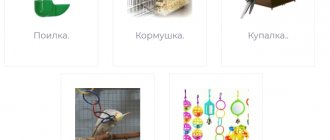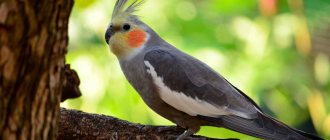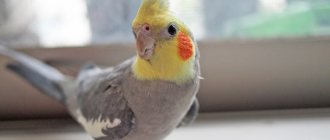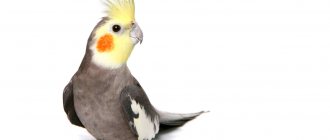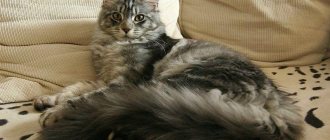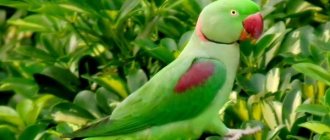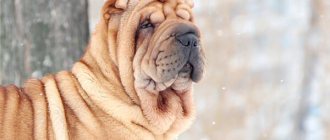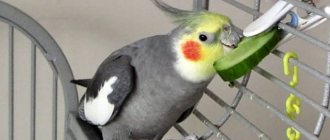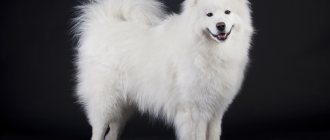Corellas are very sociable and intelligent birds. They can charm a person with their cheerful nature, love and friendly communication. This parrot loves to be in the company of its owner. Therefore, quite often a cockatiel or a nymph (another name for the same parrot) can be seen on the head or shoulders of its owner. This parrot shows its mood, ranging from happiness, curiosity, fear, illness or sadness, with the help of a crest above its head.
It is not easy for a new owner to immediately understand the character and behavior of his cockatiel. The best way to figure this out is observation. Take a closer look at your pet, note how he behaves in a given situation. After some time, you will begin to understand the behavior of the cockatiel by external signs. Then it will not be difficult for you to determine what the parrot wants. Cockatiels have a very playful character and active behavior. Head bobbing, beak scratching and rubbing, hanging upside down and tail wagging are some of the common behavioral characteristics you may notice in your budgie. The article describes what the behavior of a male or female cockatiel parrot may be like.
Origin and history of the cockatiel
In their native Australia, cockatiels are called corions or weiros. They mainly live in the outback in the northern part of the continent. Discovered in 1770, they are the smallest members of the cockatoo family.
They exhibit many of the same traits and habits as large parrots. In the wild they live in large flocks.
Corellas became popular as pet birds in the 1900s. They are easy to breed in captivity, and their docile, friendly nature makes them ideal for home life. These birds cannot currently be captured or exported from Australia.
If there are children in the house
Kids rejoice at the appearance of a colorful pet in the house, but there are a number of rules that parents should teach their children. It is important to properly arrange a home where there are birds and a small child.
To avoid any troubles, children are explained what they should absolutely not do:
- Screaming near the cage. Tell your child why the parrot is afraid of sharp sounds.
- Play with the bird like a toy: flapping, pulling out feathers, strangling.
- Open the cage without adult permission. Explain that the bird flies well and can slip out of the open window.
- You can't have a cockatiel and your small child living in the same room.
Also, parents should show by their own example how to calm excited cockatiels and how to care for them. You can train the bird together and show your child in a playful way how to wean the bird from being afraid of people.
Cockatiel Temperament
These little birds are gentle, affectionate and often love to be petted and held. They don't necessarily like to cuddle. They just want to be close to you and will be very happy to see you.
Cockatiels are usually friendly; however, a wild bird may bite. You can correct bad habits early in life by ignoring bad behavior as these birds are eager to please.
Never scold a bird; This can cause her to become timid around people. Reward good behavior and ignore bad behavior.
Cockatiels are smart birds and can learn many tricks over time. From flapping and whistling to ringing bells, these are smart little birds who will love a new trick. Many cockatiels can spend hours talking to their reflection in the mirror.
How to avoid bird bites
The pet hisses and shakes when it wants to protect its home. Perhaps it is too early to accustom him to holding hands. But it’s time to ask how to properly wean timid cockatiels from biting. First of all, natural causes that cause aggressive behavior are excluded: molting, diseases, mating season. If everything is in order, the cockatiel parrot is taught to behave calmly.
What to do in this case:
- Teach to understand the “no” command by clicking on the beak or cage to attract attention.
- If the bird is ready to attack, you can distract it with a bright toy. Find out why your cockatiel is acting aggressively: he is afraid or he has negative experiences with people.
- You can spray water on it if other methods do not help.
But when you hear the cockatiel creaking its beak, rest assured: he is used to the house and is happy. Experienced poultry keepers admit: this is the best sound you can hear from a pet.
Colors and subspecies of cockatiels
The wild cockatiel has a gray body with a yellow head, crest and orange cheek patch. Males have brighter head colors. The female has bars on the underside of her tail feathers.
Cockatiels bred in captivity for the poultry trade have developed several color mutations over the years. The most common options include:
- Albino: lack of feather pigmentation.
- Lutino: A white bird with a yellow mask, orange cheeks and red eyes.
- Pied: The typical coloring of wild cockatiels is replaced by yellow or off-white.
- Pearl, lace or opal: spots of different colors that form tiny “pearls” on the feathers.
- Cinnamon, fawn or Isabelle: Gray feathers with brown or warm brown coloring.
- Silver: Recessive silver and dominant silver cockatiel mutation; Recessives have cool gray feathers and red eyes; Dominants have a warmer gray tone and dark eyes
Other mutations include emerald, cream, pastel, white-faced and yellow-cheeked cockatiels.
The differences between males and females depend on coloration. These differences can sometimes be difficult to discern, especially in young birds.
To definitively determine gender, consider genetic testing.
Breeding period
Corellas breed during or after the rainy season, when food abundance appears. Pairs nest in the voids of thick branches and trunks of dried trees. The nest is prepared mainly by the male, the female helps a little.
A clutch usually contains from 3 to 8 white eggs. On average, this is 5. Both parents take part in incubation, which is why they differ from other parrots. The female sits at night, the male replaces her with the first rays of the sun. Birds do not leave their eggs for feeding. They also eat in shifts. The incubation period is on average 18-22 days. The hatched chicks are blind and covered with yellowish down. Parents feed them in the same way. Incubation of the clutch is replaced by incubation and heating of the chicks. After a month and a half, the young leave the nest. However, the parents continue to care for and feed the young for some time. Then the pair goes to the second clutch. In the second clutch, there are already fewer eggs. Due to the severity of the life cycle of the Australian semi-desert, girls are born in a noticeable majority in broods of cockatiels, since the possibility of continuing life is important for the preservation of the species. There are cases when there are not enough males and they are divided into two families for the sake of procreation. Australia is famous for the severity of interspecies competition and difficult conditions for the survival of many bird species.
Cockatiel care
A pair of birds will make good company for each other. But they may not communicate as well with you or imitate speech and sounds.
Keeping one bird is fine, but you will need to spend a significant amount of time interacting with your cockatiel every day. If your lifestyle makes this impossible, getting a bird or two can help prevent loneliness and self-harming behavior.
These birds are naturally dirty, with their feathers covered in powdery dust. It can leave a powdery residue on cages and accessories.
Bathe or spray your bird with water once a week. Regular cleaning of the cage is necessary. Many cockatiel cages come with a removable bottom tray to make things easier.
Cockatiels are active and playful, so they should have a large cage. Provide a cage that is at least 50 cm square and 65 cm high. The distance between the cage rods should not exceed 1 cm in width. You don't want the bird's head to get stuck in the cage.
Horizontal slats in the cage provide the bird with the best opportunity to climb and get much-needed exercise. There should be enough space in the cage to accommodate a couple of perches at different levels. The bird should move easily between perches.
Trim your cockatiel's wings and nails twice a year. You can do it yourself, but you must learn the correct method, otherwise these birds will bleed to death very easily. If you are not comfortable with this, an avian veterinarian or breeder can do this for you.
Keeping a cockatiel: what should the cage be like?
When choosing a cage for your Corella, do not forget that this bird is active and mobile, and in cramped conditions it will be completely uncomfortable. In addition, in a cage that is not the right size, the bird can injure its limbs. Therefore, the dimensions of the housing for one bird cannot be less than 50 × 40 × 60 cm, but it is still recommended to choose a more spacious cage. For a pair of Corells you will need a cage measuring 100x40x60cm, or better yet keep it in a cage measuring 150x60x90cm where the parrots can fly.
Unlike the same cockatoo, the frame of the cage can be wooden. But the rods are only stainless or chrome plated; the sharp beak can tear off the paint and poison the bird. It is better if the cage is longer in length than in height, and stands on an elevation - this will make it more comfortable for the bird. Place several pillars at different heights, put branches with bark, scalded with boiling water. It is better to attach feeders to the walls - it is more hygienic. Don't forget about fun for the bird - equip the cage with a mirror, a bell, and other toys.
It is best to cover the floor of the cage with sand. If this is not possible for any reason, clean sand should be poured into the tablet.
The parrot loves water baths, so bathing is a must.
Temperature and light conditions
The optimal temperature for keeping cockatiels is 18-25 ° C. However, one of the characteristics of these parrots is that they tolerate temporary drops in temperature quite well. Of course, they cannot be kept in drafts and frosts, but a temperature of about + 10 ° C will not harm them.
In addition, cockatiel owners should know the following. In the distant homeland of these parrots, there are clear seasonal variations in the duration of daylight and darkness. In summer, daytime for birds lasts 14 hours, in winter - 10 hours. It is recommended to create a similar regime when keeping cockatiels at home.
It is also recommended to install and turn on an ultraviolet lamp from time to time - a source of bird health.
General health problems
The most common health problem in cockatiels is malnutrition. Too often they are fed only seeds.
They need the vitamins and minerals found in fruits, vegetables and a pellet-based diet to prevent malnutrition.
Cockatiels are prone to fatty liver disease, which occurs as a result of a high-calorie diet rich in carbohydrates and fats and limited or no exercise.
To reduce your cockatiel's risk of contracting this disease, make sure your bird has a varied diet and keep it away from insecticides, pesticide residues on fruits and vegetables, and cleaning product fumes.
Most birds are susceptible to respiratory disease and psittacosis, a dangerous bacterial infection that can cause respiratory symptoms such as wheezing, sneezing, coughing and nasal discharge. Take your bird to the veterinarian at the first sign of illness. Quick action can save your bird's life.
Raising the crest
This is very similar to how we humans raise our eyebrows or enlarge our eyes when we are afraid of something. The cockatiel raises its crest and sometimes hisses when it is afraid. A pet can be afraid of anything. For example, other pets or an inanimate object that makes her uncomfortable. Even the light from a car passing outside the window or the shadow from a door can frighten a parrot. In addition, the cockatiel's crest rises if it is angry or upset. In such situations, do not get too close to the cage. Also, speak politely to your cockatiel, showing that you have no intention of harming it.
How and what to feed cockatiels
Variety is the key to a healthy diet for any parrot, including cockatiels. Seeds can be a nutritious part of the diet, but they are high in fat.
Seeds should make up no more than 30 percent of the bird's diet. A pelleted diet is the right choice for birds because it is nutritionally balanced.
To ensure your bird gets all the nutrients it needs, offer it a variety of fresh vegetables and fruits. In general, a cockatiel will eat about 1 tablespoon of food per day. That's why what goes into that tablespoon matters.
Give a mixture of seeds and granules every morning. Give as much as the bird will eat. Cockatiels are not prone to overeating. You can put the food in a bowl or scatter it on the floor of the cage.
These birds are natural forage consumers in the wild, where they eat grass seeds, fruits and plants. Place fresh fruits and vegetables in a bowl. Remove what they don't eat after an hour; Do not feed your bird spoiled food.
If your bird prefers a seed diet, you will need to be persistent in getting him to eat a more varied menu. Offer proteins such as hard-boiled eggs, legumes and sausages in moderation.
Sprouted seeds are also a great way to add variety to your bird's diet. Never feed avocado, chocolate, coffee and salt; these items are toxic to birds.
Scream
Seeing your beloved pet scream and squeal is a frightening sight. The following reasons for this behavior in cockatiels are identified:
- Adverse changes in the environment.
- There is too much noise around the cage.
- You are going to leave the bird alone.
- The parrot doesn't get enough sleep.
On average, cockatiels need to sleep at least 10 to 12 hours a day.
Exercises
As with any parrot, exercise will keep your cockatiel happy and help maintain its physical and mental health.
If your bird spends most of its time in a cage, make sure it is large enough for the bird to fly. Provide a variety of toys that can stimulate the bird's natural inclination to play. There should be a lot of perches, ladders and toys, but not to such an extent that it interferes with the bird’s ability to move around the cage.
If possible, give your cockatiel at least an hour out of the cage. Although it is not as important as with other parrots, getting out of the cage helps with socialization and allows the bird to spread its wings.
Pros of a Corella parrot
- Small parrot
- A quiet bird that can learn to talk
- Does not require much time outside the cage
Minuses
- Can bite hard, even if it's a tame parrot
- When keeping a pair of cockatiels, the birds will never speak
General impression
Corella parrots are friendly and trusting birds. However, without constant communication with the owner, the cockatiel can quickly turn into a wild parrot, responding with aggression to any human movement. After all, these are very proud birds that do not tolerate disdain for their person.
Cockatiels can become devoted companions who fall in love with their owner. But the parrot will reciprocate only if you give your pet daily attention, take care of it, play, and periodically let it out of the cage. And then you will be able to feel how they amusingly finger the hair on your head as a sign of their fidelity and boundless love.
Only by respecting the cockatiel and satisfying his personal needs can you buy an affectionate pet that will greet you with joyful cries every time. Of course, not all birds are the same; each has its own personality and preferences. But in general, these parrots are pleasant birds to talk to.
Let's take a closer look at some of the behavioral features of these parrots.
Where to buy cockatiel
When choosing a bird, it is better to choose a hand-fed chick or a young bird that is regularly handled. Prices will vary depending on the color and the reputable breeder. A cared for chick can cost between $100 and $300.
Cockatiels are widely available in pet stores, but the history of these birds may be unknown. As a result, they may be older than their stated age, unaccustomed to people and hands, and more difficult to tame.
Look for a bird that is bright, alert and active. Avoid birds that sit quietly with puffy feathers; this could be bad. The bird's feathers should be smooth and shiny, lying flat on the body.
The feathers around the anus/cloaca (the opening through which the bird excretes feces and urine) should be clean, dry and free of feces. The scales on the feet should be smooth. Make sure its claws are in good condition and its beak is smooth and well shaped. The nostrils should be clean.
If the parrot flies away
A bird owner may leave a window or door open and not notice the cockatiel flying away. We need to try to get him back. You need to understand that the pet is not far away. He, scared and confused, hides in a tree in the yard.
To attract the attention of a fugitive, do the following:
- Play a recording of the chirping of parrots of his species or melodious music on the windowsill.
- They place a feeder with his favorite food on the window.
- If there are other birds in the house, take them outside in a cage.
- You need to walk along the nearest streets and call your pet. Perhaps he will respond.
Not always, if a cockatiel parrot has flown away, it is useless to look for it. But the likelihood that, under the influence of hunger, he will find his way to another house is high. The death of the bird is not excluded.
Winning the heart of a cockatiel is not difficult if you work at it every day. The main tool for creating a friendly relationship with your pet is love and patience. Over time, the nimble bird will become a full member of the family. Her sweet talk and awkward dances will not let you get bored even on the gloomiest days. And remember: let your cockatiel squeak his beak more often.
How to choose a future “talker”
All cockatiels can remember and reproduce sounds, but not all will easily learn new things and repeat what their owner would like to hear. In order for your pet to be a capable student, you need to know some selection criteria.
Features of sounds and behavior
Birds convey their reactions to various stimuli not only through sounds. There is also appropriate behavior that can complement and understand the reason for the cry.
Creak and grind
This is how the bird reacts to interaction with people. The creaking of the beak is a sign of pleasure. The cockatiel often “purrs” in this way after a meal or before bed . He calms himself with such sounds.
Grinding occurs when the beak is worn down. The bird needs a piece of chalk, metal or sepia to help grind down its overgrown beak.
The crest rises
If a cockatiel's crest rises along with a loud sound, then this action is compared to a human grin and raising of eyebrows. This is how the bird reacts to:
- bright, new items;
- other animals or people;
- loud, unfamiliar sounds.
Sometimes a parrot expresses frustration or dissatisfaction with a cry and a ruffled “forelock.” Then you need to calmly talk to the bird and calm it down.
Corella with a tufted crest.
Hanging upside down
If your feathered pet hangs upside down and screams, you shouldn’t be surprised. Animals often sway and fluff their tails. This strange behavior of the parrot is his desire to bathe or splash.
Cockatiels are big splashers.
Parrot selection and taming
If you decide that a nymph is the most desirable pet for you, try to buy it in a specialized nursery, where there are all the conditions for breeding and raising young animals. Most pet stores cannot provide good temporary housing conditions for birds.
When choosing a cockatiel, you need to focus on the following parameters:
- if you want your parrot to quickly get used to you and become tame, choose a young bird, 1 month old;
- inspect the plumage of the cockatiel, it should be neat, without kinks, the feathers fit tightly to each other;
- there should be no growths or cracks on the beak;
- eyes are clear, shiny, without discharge;
- the cloaca is clean, without dirty feathers around;
- a young and healthy cockatiel is an active, inquisitive and cheerful bird, but a silent and ruffled parrot sitting motionless on a perch is an alarming signal, the bird is either old or has some kind of disease.
About the difficulties you may encounter when choosing a parrot, as well as the disadvantages of keeping cockatiels at home, watch this video:
What to do in especially severe cases
If the parrot does not take its owner seriously and remains wild, it is better to give up trying to tame it. The bird will probably not get used to humans and will be afraid of everything. In this case, it is worth moving the cockatiel to a large enclosure so that it can fly there. Then you won’t have to subject the bird to additional stress by letting it out of the cage for a walk.
Elegant birds with crests and bright cheeks are not as friendly as you might think. The cockatiel has a small beak, but its bites are quite noticeable. To minimize or completely prevent hostile attacks from your ward, you need to educate him correctly: stop bad behavior, monitor the tone of communication and be able to find an approach to each individual.
Source
Health and illness
With proper care, the cockatiel rarely gets sick. If this happens, the main thing is to promptly seek help from a veterinarian. Then there is a chance to save the bird.
- Parasites. You need to watch the bird. With apathy and loss of appetite, it is worth talking about the disease. The plumage can tell a lot if it is dull or brittle - this indicates infestation with parasites.
- If the plumage is severely damaged, the cockatiel may be bothered by bird mites. In this case, you cannot do without the help of a veterinarian. Feather or scabies mites cause serious pain to the bird.
- Cockatiels are susceptible to intestinal diseases. A sign of a disturbance in the functioning of the stomach will be soiled feathers near the cloaca.
- The consequences of a poor diet can be muscle atrophy, and the contours of the bird’s chest can be felt.
- Goiter inflammation. An important point is the condition of the beak. It should be shiny without abscesses or tumors.
- Conjunctivitis. The eyes should be clear and clean and free of pus.
